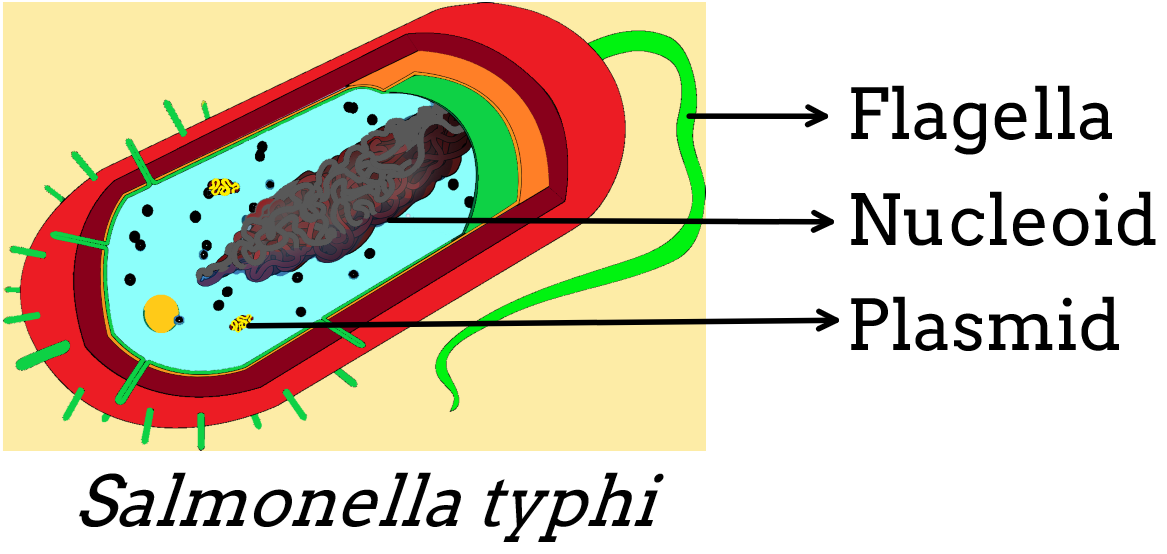
Name the causative organism of typhoid and draw its diagram.
Answer
495k+ views
Hint: Typhoid is a waterborne disease that is caused by bacteria living as intestinal parasites.
Complete answer:
The causative agent of typhoid is ‘Salmonella typhimurium'. Salmonella typhimurium are gram-negative bacilli that possess peritrichous flagella for movement. They are aerobic and facultative anaerobic organisms. The bacteria was first isolated by Salmon and Smith in 1885 and they named it Salmonella.
Typhoid fever is acquired by the ingestion of contaminated food and water with the bacteria. On reaching the small intestine the bacteria attach to the epithelial cells of the intestinal villi and penetrate into the submucosa layer of the intestinal wall. The infection can also spread to liver, gallbladder, kidney, bone marrow, spleen, etc. They multiply abundantly in the gallbladder.
Additional Information:
1. The pathogenicity of Salmonella is due to its antigenic structure. It consists of three antigens-
- H-antigen- It is present in the flagella. It prevents the bacteria from destruction by chemicals like acids and alcohols.
- O-antigen- It is present on the cell wall. It makes the bacteria resistant to boiling, acids, and alcohols. It acts as a toxin.
- Vi-antigen- It is also present on the cell wall covering the O antigen.
2. Typhoid along with Parathyroid fever (caused by Salmonella paratyphi) is commonly known as ‘enteric fever'.
3. Human beings are the only natural host for Salmonella typhi and Salmonella paratyphi.
4. Mary Mallon, commonly known as Typhoid Mary was responsible for causing several outbreaks of typhoid for around 15 years by serving infected food in her restaurants.
Note:
1. Typhoid can be diagnosed by the Widal test. It detects the formation of natural antibodies against the structural antigens in our bodies.
2. It can also be diagnosed by ELISA and can easily be detected in feces and urine.
3. The ingested bacteria are discharged continuously into the Peyer's patches and lymphoid follicles of the ileum.

Complete answer:
The causative agent of typhoid is ‘Salmonella typhimurium'. Salmonella typhimurium are gram-negative bacilli that possess peritrichous flagella for movement. They are aerobic and facultative anaerobic organisms. The bacteria was first isolated by Salmon and Smith in 1885 and they named it Salmonella.
Typhoid fever is acquired by the ingestion of contaminated food and water with the bacteria. On reaching the small intestine the bacteria attach to the epithelial cells of the intestinal villi and penetrate into the submucosa layer of the intestinal wall. The infection can also spread to liver, gallbladder, kidney, bone marrow, spleen, etc. They multiply abundantly in the gallbladder.
Additional Information:
1. The pathogenicity of Salmonella is due to its antigenic structure. It consists of three antigens-
- H-antigen- It is present in the flagella. It prevents the bacteria from destruction by chemicals like acids and alcohols.
- O-antigen- It is present on the cell wall. It makes the bacteria resistant to boiling, acids, and alcohols. It acts as a toxin.
- Vi-antigen- It is also present on the cell wall covering the O antigen.
2. Typhoid along with Parathyroid fever (caused by Salmonella paratyphi) is commonly known as ‘enteric fever'.
3. Human beings are the only natural host for Salmonella typhi and Salmonella paratyphi.
4. Mary Mallon, commonly known as Typhoid Mary was responsible for causing several outbreaks of typhoid for around 15 years by serving infected food in her restaurants.
Note:
1. Typhoid can be diagnosed by the Widal test. It detects the formation of natural antibodies against the structural antigens in our bodies.
2. It can also be diagnosed by ELISA and can easily be detected in feces and urine.
3. The ingested bacteria are discharged continuously into the Peyer's patches and lymphoid follicles of the ileum.

Recently Updated Pages
Master Class 11 Economics: Engaging Questions & Answers for Success

Master Class 11 Business Studies: Engaging Questions & Answers for Success

Master Class 11 Accountancy: Engaging Questions & Answers for Success

Master Class 11 English: Engaging Questions & Answers for Success

Master Class 11 Computer Science: Engaging Questions & Answers for Success

Master Class 11 Maths: Engaging Questions & Answers for Success

Trending doubts
Why was the Vernacular Press Act passed by British class 11 social science CBSE

Name the nuclear plant located in Uttar Pradesh class 11 social science CBSE

What steps did the French revolutionaries take to create class 11 social science CBSE

One Metric ton is equal to kg A 10000 B 1000 C 100 class 11 physics CBSE

How did silk routes link the world Explain with three class 11 social science CBSE

Difference Between Prokaryotic Cells and Eukaryotic Cells




